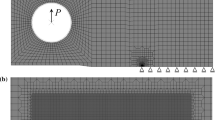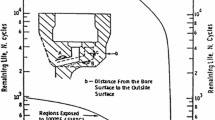Abstract
The heat resistant material, Alloy 800H, is presently used in pctrochemical processes and for steam superheater tubing in power generation systems. In service, the alloy may experience steady loading, cyclic loading, or a combination of the two. In this paper, crack growth behavior under fatigue, creep, and hold time loading conditions has been characterized as a temperature of 650 ‡C in laboratory air. Fatigue crack growth rate (per second) was observed to increase with increasing frequency. The linear elastic fracture mechanics (LEFM) parameter, δK, was found to be a useful parameter to correlate crack growth rates for fatigue. In creep and hold time cases, where significant plasticity was observed, the energy rate line integral parameter, C*, is a useful descriptive parameter. In fact, C* is capable of consolidating all creep and hold time data into a single straight line on a logarithmic plot. Both creep and hold time tests show the same characteristic deflection curves. This demonstrates that hold time tests are more creep-like than fatigue-like for the test conditions here. Compared to creep loading, fatigue deflection curves show much less induced plasticity, most of which is gathered during the final stages of the experiments at high-stress intensity values. Microstructural examination revealed that a transgranular crack growth mode is predominant during fatigue, while both creep and hold time tests are cavity-controlled crack growth processes with the exception that striations are observed along cavity edges in the hold time tests.
Similar content being viewed by others
References
ASME Boiler and Pressure Vessel Code, ASME, New York, NY, 1983.
ASTM. Standard E647-86,1986 Annual Book of ASTM Stan- dards, ASTM, Philadelphia, PA, 1986, vol. 3.01, pp. 714–36.
L.A. James, J.L. Straalsund, and R.E. Bauer:J. Nucl. Mater., 1979, vol. 85-86, pp. 851–54.
ASTM Standard E399-81,1986 Annual Book of ASTM Standards, ASTM, Philadelphia, PA, 1986, vol. 3.01, pp. 522–57.
K.H. Schwalbe:J. Test. Eval., 1981, vol. 9 (3), pp. 218–20.
H.H. Johnson:Material Research and Standards, 1965, vol. 5, pp. 442–45.
J.D. Landes and J.A. Begley: inMechanics of Crack Growth, ASTM STP 590, ASTM, Philadelphia, PA, 1976, pp. 128–48.
C. E. Jaske: inThe Mechanism of Fracture, ASM, Metals Park, OH, 1986, pp. 577–85.
J.R. Foulds: Presented at the 3rd Int. Symp. on Non-Linear Frac- ture Mechanics, Knoxville, TN, 1986, ASTM STP, in press.
H. Riedel: inFracture at High Temperatures, Springer-Verlag, New York, NY, 1987, pp. 373–75.
K. SActananda and P. Shahinian:Metall. Trans. A, 1983, vol. 14A, pp. 1467–80.
V.M. Radhakrishnan and A.J. McEvily:J. Eng. Mater. Tech., 1980, vol. 102, pp. 200–06.
A. Saxena and J.D. Landes:in Advances in Fracture Research: Proc. 6th Int. Conf. on Fracture, 1984, vol. 6, pp. 3977–88.
S. Taira, R. Dhtani, and T. Komatsu:Trans. ASME, 1979, vol. 101, pp. 154–67.
A. Saxena: inFracture Mechanics, ASTM STP 700, ASTM, Philadelphia, PA, 1980, pp. 131–51.
D. Smith and G.A. Webster: inElastic-Plastic Fracture, ASTM STP 803, ASTM, Philadelphia, PA, 1983, pp. 654–74.
K.M. Nikbin, D.J. Smith, and G.A. Webster:Trans. ASME, 1986, vol. 108, pp. 186–91.
K. Krompholz, E. Boamann, G. Gnirss, and H. Huthmann:J. Nucl. Technol., 1984, vol. 66, pp. 371–79.
J.R. Foulds:Proc. of the Failure Analysis and Related Papers, presented at the Int. Conf. on Fatigue, Corrosion Cracking, Frac- ture Mechanics, and Failure Analysis, ASM, Metals Park, OH, 1986, pp. 269–78.
L.A. James:J. Eng. Mater. Tech., 1974, vol. 96, pp. 249–54.
P. Shahinian:Met. Technol., 1978, vol. 5, pp. 372–80.
Author information
Authors and Affiliations
Rights and permissions
About this article
Cite this article
Hour, K.Y., Stubbins, J.F. The effects of hold time and frequency on crack growth in alloy 800H at 650 °C. Metall Trans A 20, 1727–1734 (1989). https://doi.org/10.1007/BF02663204
Received:
Issue Date:
DOI: https://doi.org/10.1007/BF02663204




